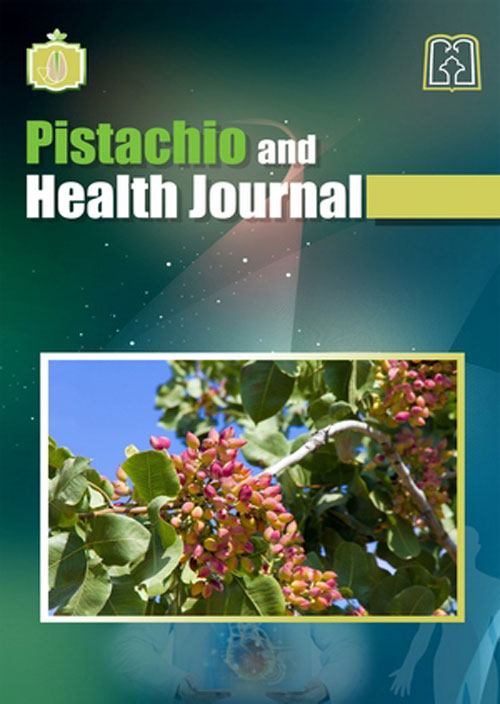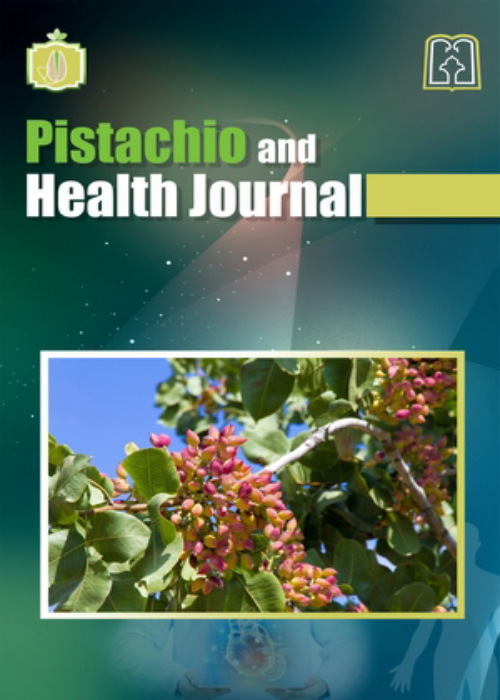فهرست مطالب

Pistachio and Health Journal
Volume:3 Issue: 4, Autumn 2020
- تاریخ انتشار: 1400/02/12
- تعداد عناوین: 7
-
Pages 4-20Introduction
Different parts of pistachio are precious sources for preparing new candidates for bio-molecule drugs to manage diseases such as cancer, obesity and diabetes. According to our previous study, the protein hydrolysates of pistachio kernels (PHPK) are capable of inhibiting the mechanism of the diabetes. The aim of this study was to investigate the effect of PHPK on kidney biochemical and histopathological indices in STZ induced diabetic and high-sugar diet-fed rats.
Materials and MethodsNinety-six Wistar male rats weighing approximately 250-300g were randomly divided into 12 groups of eight: three control groups and nine target groups (including rats with normal diet, rats with high-sugar diet and streptozotocin-diabetic rats with a normal diet), which were fed with different doses of PHPK for 8 weeks. Then the kidney function was measured using biochemical and histopathological assays.
ResultsThe results demonstrated a reduction in the level of creatinine due to recovery in the glomerular filtration and repair of the cell damage caused by STZ. The PHPK and the ingredients showed therapeutic potential for kidney injuries preceded by STZ. In all dosages of PHPK, urea and creatinine levels decreased significantly, which is possibly correlated with the better protection of the kidneys (P≤0.05). After PHPK treatment, the levels of urea and creatinine decreased and the renal function improved.
ConclusionsTreatment with PHPK demonstrated a potential diabetes mellitus therapeutic effect. Specifically, higher treatment with dose corresponds to better renal function and better activity through the mechanistic action to reduce creatinine and urea levels in STZ-injected Wistar rats.
Keywords: Diabetes, Protein Hydrolysates of Pistachio Kernels, Kidney Function -
Pages 21-32
It goes without saying that the most important problem of the country’ pistachio exports is the contamination of pistachios with Aspergillus flavus and aflatoxin. The liver and kidney are the tissues targeted by aflatoxin that leads to carcinogenic effects. The contamination of pistachios with this toxin can threaten the main source of foreign exchange earnings, and prevent the producers from competing in the global market. In Iran and other pistachio-producing countries, contamination by Aspergillus species occurs during the growth phase as well as during or after the processing phases. As much as 2.5% of the world’s agricultural products are contaminated with mycotoxins. At present, the maximum allowed levels for aflatoxin B1 and total aflatoxin are 1-20 ng g-1 and 0-35 ng g-1 , respectively. The Iranian Institute of Standard and Industrial Research has set the highest acceptable levels of aflatoxin B1 and total aflatoxin in pistachios at 5 and 15 ng g-1 , respectively. Mechanical separation techniques, thermal inactivation, and irradiation are among the methods of decontamination and fungus control after pistachio harvesting. Ionizing radiation decontamination is a highly efficient, safe and environmental-friendly process that can be used for decontamination.
Keywords: Aspergillus, Aflatoxin, Fungus Contamination, Pistachio, Decontamination Methods -
Pages 33-49Introduction
Pistachio butter is one of the products of pistachio processing industry that has a high nutritional value as well as high added value.
Materials and MethodsIn this original study, pistachio butter produced under different conditions of temperature, grinding time, and sugar-to-honey ratio was evaluated in terms of oxidation (acidity, peroxide value and anisidine value). Pistachio butter samples were stored in a refrigerator (4 °C) for 6 months. Sampling time was in the time period of zero to six and with an interval of two months.
ResultsIn investigating the optimal points, the acid value of four treatments (containing 10% honey) confirmed the mutual intensification property existing between temperature and grinding time and sugar-to-honey ratio. The use of low temperatures and grinding times as well as the usage of honey instead of sugar in the composition of pistachio butter reduced the acid value in the treatments. With increasing the time and temperature of grinding, the peroxide value increased and the highest peroxide value was observed in 6 hours and a temperature of 45 °C. The anisidine value increased with increasing temperature and grinding time in all samples of pistachio butter. Moreover, the anisidine value increased significantly with increasing the sugar-to-honey ratio in all samples.
ConclusionPistachio butter containing honey has less oxidation than pistachio butter containing sugar.
Keywords: Pistachio Butter, honey, oxidation -
Pages 50-62
Polyphenols are micronutrients with an extensive range of biological characteristics including a reduction in inflammation features. Pistachio is rich in polyphenols, and therefore, contains the antiinflammatory potential for various anti-inflammatory conditions. To date, beneficial anti-inflammatory effects of pistachio or its derivatives have been demonstrated in several inflammatory conditions such as colitis and paw edema. A number of conditions, including diabetes, obesity, and cardiovascular disorders have also been found to benefit from pistachio supplementation. Growing evidence suggests that pistachio could be more widely used in inflammatory conditions. Pistachio and its derivatives seem to exert anti-inflammatory effects through several direct and indirect mechanisms. However anti-inflammatory properties of pistachio need to be further investigated in the context of other inflammatory conditions such as inflammatory and autoimmune arthritis, systemic lupus erythematous, tendonitis etc.
Keywords: Pistachio, Inflammation, anti-inflammatory -
Pages 63-76Introduction
Dyes are among dangerous contaminants that are often found in textile wastewater. These pollutants have significant health effects on humans, and destructive environmental effects on the ecosystem of aquatic plants and animals, and can alter the physicochemical properties of water. Hence, in this work, the methylene blue (MB) dye removal using sawdust of pistachio tree was investigated.
Materials and MethodsThis study was performed experimentally on a laboratory scale. The influence of various factors including dye concentration, pH of the solution, sawdust of pistachio tree dosage, and reaction time on dye removal efficiency was investigated.
ResultsThe results showed that under optimized conditions of dye concentration of 50 mg L-1 , pH of solution equal to 8.0, sawdust of pistachio tree dosage equal to 0.14 g L-1 and reaction time of 100 min, was 99.7%. The adsorption process follows the second order kinetics of R2= 0.9931 and the Langmuir isotherm R2= 0.9943.
ConclusionThe adsorption process using sawdust of pistachio tree can be used as a high efficiency economic adsorbent in textile wastewater treatment.
Keywords: Adsorption, Sawdust of Pistachio Tree, Methylene blue dye, textile industry, Kinetics, Isotherm -
Pages 77-99Introduction
Aflatoxin is the most significant mycotoxin hazard to human health, a secondary metabolite characterized by mutagenicity, teratogenicity, and carcinogenicity. It is produced by some species of Aspergillus in susceptible agricultural crops under certain environmental conditions. Different strategies, such as physical, cultural, biological, and chemical, have been suggested to manage the contamination of various crops with Aspergillus fungus. Using atoxigenic isolates of Aspergillus flavus is considered an effective and successful method in reducing aflatoxin contamination.
Materials and MethodsIn the present study, 58 atoxigenic isolates of Aspergillus flavus obtained from pistachio orchards in different agro-ecological zones of Iran were used. Coconut agar medium (CAM) Petri plates were co-inoculated by an equal number of spores (4×103 ) of 58 atoxigenic and one toxigenic strain. The interactions between toxigenic and atoxigenic strains to produce aflatoxin were evaluated by exposing them to ammonia vapor. Potato dextrose broth (PDB) medium was used to produce mycelium, and the CTAB modified method was used to extract DNA. Species-specific primer was used for molecular identification. Four genes, including nor1, avnA, estA, aflR, and C3 region of the aflatoxin gene cluster, were detected in 24 atoxigenic isolates using specific primers and PCR reaction.
ResultsOverall, the isolates were divided into six groups based on the color intensity of the back of the colony. Atoxigenic isolates were placed into 12 groups on the basis of the gene deletion pattern.
ConclusionIn vitro competition test showed a potential for limiting toxigenic A. flavus strains growth and aflatoxin control among atoxigenic strains
Keywords: Food Safety, Biological Control, Nontoxigenic, Ammonia Vapor


